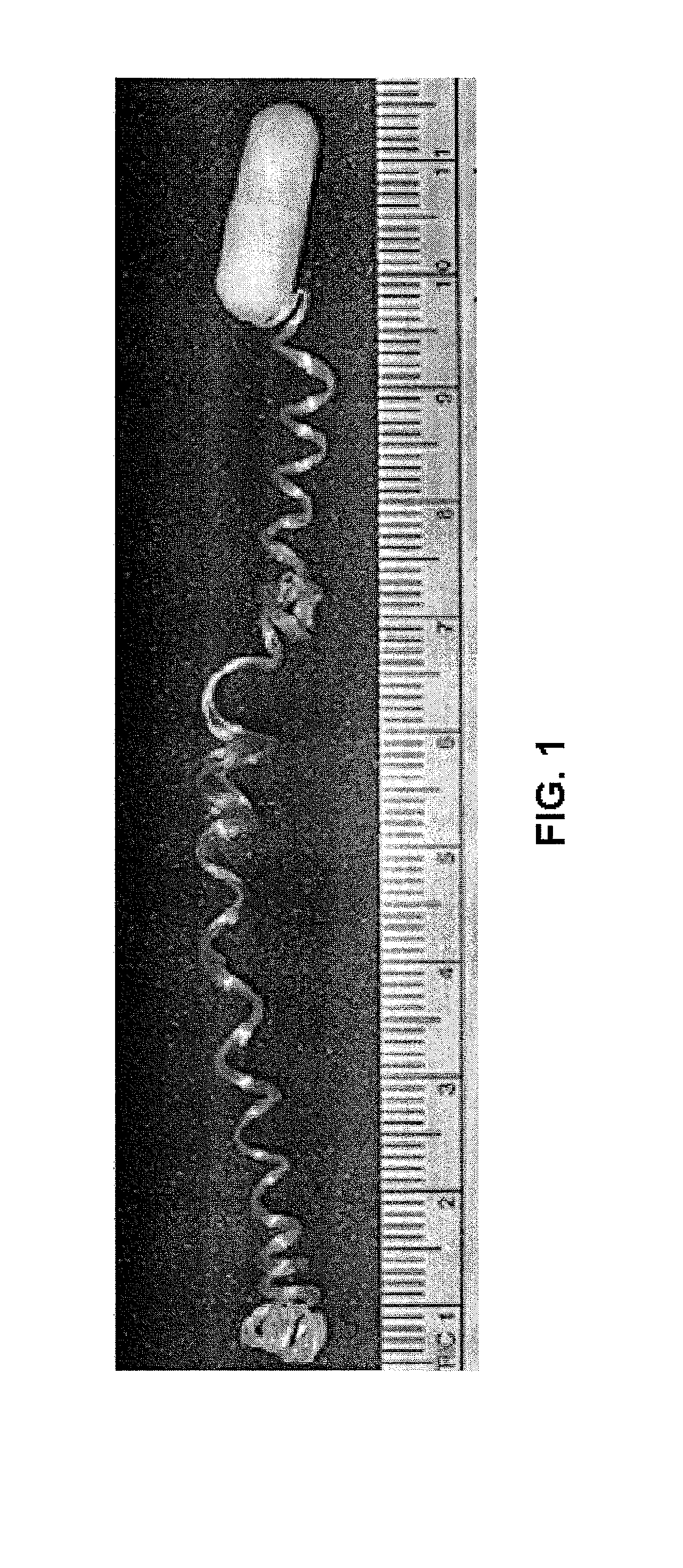Minimally-invasive measurement of esophageal inflammation
a technology of esophageal inflammation and measurement method, applied in the field of medicine, can solve the problems of difficult diagnosis of inflammatory conditions of the gastrointestinal tract, eosinophilic gastroenteritis (ege), inflammatory bowel disease (ibd), etc., and achieves the effect of not being useful for cell-mediated reactions, serologic and radiographic assessments are not diagnostic, and not being useful for diagnosis
- Summary
- Abstract
- Description
- Claims
- Application Information
AI Technical Summary
Problems solved by technology
Method used
Image
Examples
example 1
[0101]The string test was administered to a patient with reflux esophagitis and left in place for 1 and 12 hours. The first 10-20 cm of the string was pulled out from the capsule and the end of the string was secured between the fingers. The capsule and remaining string were swallowed with water and the string in the fingers was taped to the cheek. After the predetermined period, the taped string was removed from the cheek and the string retrieved from the intestinal tract. Following removal, the contents of the string were assessed for the presence of inflammatory proteins and RNA. The entire string was placed either in protein buffer, RNA stalizing solution or formalin. After 1 and 12 hours in the esophagus, elevations of interleukin-8 and TNF α-protein were identified by Mesoscale and ELISA technology. In these studies, protein was extracted from the string, and the soluble product was placed in the well of a 96-well plate for analysis. Following placement of the soluble product ...
example 2
[0102]Identification of microbial flora from EST. Identification and enumeration of esophageal and oral bacterial population by selective culture.
[0103]Microbial culture. Strings were swallowed or remained in the mouth for 15 min. A 5 cm piece of esophageal or oral string was aseptically transferred to 5 ml of sterile Hank's Buffered Salt Solution (HBSS) and vortexed for 30 sec before a 5 min incubation at RT. For nasal secretion collection swap was humidified in sterile saline; a nasal swab was collected using a BBL™ culture swab. String and nasal solution was vortexed again for 30 sec and the string removed. The solution was centrifuged for 15 min at 4750 rpm. Supernatant was aspirated and the pellet was resuspended in 1 ml of sterile HBSS. Dilutions up to 10−5 were performed and 50 ml of non diluted samples or 10−5 dilution was plated in duplicate onto selective media. Plates were incubated at 37° C. overnight in aerobic or anaerobic (BD Bioscience Gas Packs) conditions. Plate co...
example 3
[0105]Measurements of eosinophil derived granule proteins from the Esophageal String Test (EST) can detect histological evidence of esophageal inflammation associated with EE. Preliminary results show that supernatants derived from activated eosinophils adhere to the EST and that eosinophil derived granule proteins within these samples can be measured by Western blot and ELISA analyses. These findings support the technical feasibility for the EST to be used to measure eosinophil derived granule proteins contained in the esophageal lumen of patients with EE.
[0106]Detection of eosinophil granule major basic protein-1 (MBP1) on EST strings incubated with acidic lysates of resting eosinophils. In order to demonstrate the ability of EST string to detect eosinophil granule cationic proteins, purified blood eosinophils from normal subjects (>99% eosinophils) were used to prepare soluble acidic lysates by sonication of different numbers of eosinophils (1×105 or 1×106 cells) in either 0.1N H...
PUM
| Property | Measurement | Unit |
|---|---|---|
| time | aaaaa | aaaaa |
| time | aaaaa | aaaaa |
| diameter | aaaaa | aaaaa |
Abstract
Description
Claims
Application Information
 Login to View More
Login to View More - R&D
- Intellectual Property
- Life Sciences
- Materials
- Tech Scout
- Unparalleled Data Quality
- Higher Quality Content
- 60% Fewer Hallucinations
Browse by: Latest US Patents, China's latest patents, Technical Efficacy Thesaurus, Application Domain, Technology Topic, Popular Technical Reports.
© 2025 PatSnap. All rights reserved.Legal|Privacy policy|Modern Slavery Act Transparency Statement|Sitemap|About US| Contact US: help@patsnap.com



